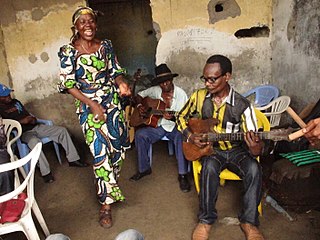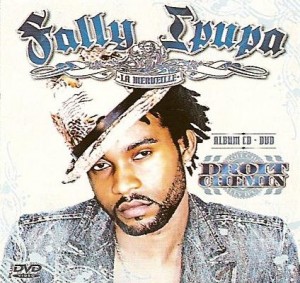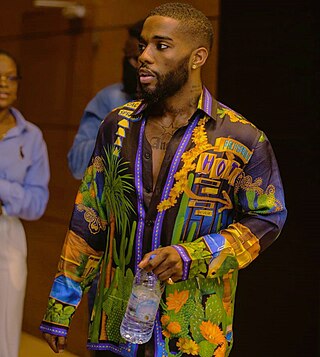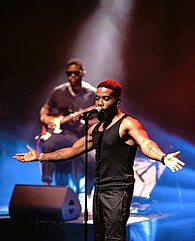
Congolese music is one of the most influential music forms of the African continent. Since the 1930s, Congolese musicians have had a huge impact on the African musical scene and elsewhere. Many contemporary genres of music, such as Kenyan Benga and Colombian Champeta, have been heavily influenced by Congolese music. In 2021, Congolese rumba joined other living traditions such as Jamaican reggae music and Cuban rumba on UNESCO's "intangible cultural heritage of humanity" list.

Soukous is a genre of dance music originating from the Democratic Republic of the Congo and the Republic of the Congo. It derived from Congolese rumba in the 1960s, with faster dance rhythms and bright, intricate guitar improvisation, and gained popularity in the 1980s in France. Although often used by journalists as a synonym for Congolese rumba, both the music and dance associated with soukous differ from more traditional rumba, especially in its higher tempo, song structures and longer dance sequences.

Jules Shungu Wembadio Pene Kikumba, known professionally as Papa Wemba, was a Congolese singer and musician who played Congolese rumba, soukous, and ndombolo. Dubbed the "King of Rumba Rock", he was one of the most popular musicians of his time in Africa and played an important role in world music. He was also a fashion icon who popularized the Sape look and style through his musical group Viva la Musica, with whom he performed on stages throughout the world.
Zaïko Langa Langa is a Congolese rumba band formed in Kinshasa, in December 1969. Established by D.V. Moanda, Henri Mongombe, Marcellin Delo and André Bita, the band evolved from the Orchestre Bel Guide National, which is seen as Zaïko's predecessor. Other co-founders included Papa Wemba, Jossart N'Yoka Longo, Félix Manuaku Waku.

Antoine Christophe Agbepa Mumba, known professionally as Koffi Olomidé, is a Congolese singer-songwriter, dancer, producer, and founder of Quartier Latin International. Often referred to as the "King of Ndombolo", he is noted for his explosive high notes, deep baritone, and offbeat voice. Agbepa is considered one of the most significant figures in 20th-century Congolese and African popular music. His lyrics often explore themes of love, politics, technology, success, infidelity, religion, chicanery, and disillusionment. Through his music and stage performances, he introduced the slower style of soukous known as Tcha Tcho and popularized a flamboyant fashion subculture called La Sape, alongside Papa Wemba.

The Stade des Martyrs de la Pentecôte, or simply the Stade des Martyrs, is the national stadium of the Democratic Republic of the Congo (DRC), located in the Kinshasa commune of the capital Kinshasa. With a seating capacity of 80,000, it is the largest stadium in the DRC and the fourth-largest stadium in Africa. It serves as the home stadium for the Congolese football national team, AS Vita Club, and DCMP, making it the largest multifunctional venue in the country.

Congolese rumba, also known as African rumba, is a dance music genre originating from the Republic of the Congo and Democratic Republic of the Congo. With its rhythms, melodies, and lyrics, Congolese rumba has gained global recognition and remains an integral part of African music heritage. In December 2021, it was added to the UNESCO list of intangible cultural heritage.
Barbara Kanam Mutund, known professionally as Barbara Kanam, is a Congolese singer-songwriter, music producer, actress, philanthropist, and currently serves as the Director General of the Cultural Promotion Fund of the Democratic Republic of the Congo. She gained fame after being discovered by Alpha Blondy and producer Dodo Kone, who helped her release her debut studio album Mokili in 1999. The album's gospel-influenced lead single "Mokili Ekoleka" earned her a television appearance at the Koras Awards. Teti, her second studio album, released in 2003, won her Most Promising African Female Artist at the 2003 Kora Award. Teti won her many accolades, including two consecutive Best Female of Central Africa for Kunde d'Or and Tamani d'O in 2004, two consecutive Black Music Awards for Best Female and Best Video for "Bibi Madeleine" in 2005.

Fally Ipupa N'simba, known professionally as Fally Ipupa, is a Congolese singer-songwriter, dancer, philanthropist, guitarist, and producer. Often referred to as the "Prince of Rumba", he is noted for his tenor vocals as well as his blend of contemporary and traditional Congolese music genres, including Congolese rumba, soukous, and ndombolo. His lyrics often cover themes of romance, suffering, and joy.
Innocent Didace Balume, known professionally as Innoss'B, is a Congolese singer-songwriter, rapper, percussionist, dancer, and philanthropist. Often referred to as the "Jeune Leader," he is renowned for pioneering the AfroCongo music genre, an eclectic fusion of Congolese rumba, indigenous folklore, and ndombolo.

Droit Chemin is the debut solo studio album by Congolese singer Fally Ipupa. It was released on June 10, 2006. The album was produced by David Monsoh. The album features guest appearances from Barbara Kanam, Maïka Munan, Krys, Mokobé, and Benji of Nèg' Marrons. It went gold for selling more than 100,000 copies in one month.
Gecko Bouro Mpela, also known as Bouro Mpela, is a soukous singer, dancer, and performer from the Democratic Republic of the Congo. He was a member of the Quartier Latin International band, which was founded and led by Koffi Olomide.

Candy Nkunku, known professionally as Cindy Le Coeur, is a Congolese recording artist, singer, and dancer. She is a member of the Congolese band Quartier Latin International, formed and led by prolific musician Koffi Olomide.

Hervé Gola Bataringe, known professionally as Ferré Gola or Ferre Gola, is a Congolese singer-songwriter, dancer, and record producer. Revered as the "Jésus de Nuances", he is regarded as one of the most significant figures of the fifth-generation Congolese rumba. His lyrics predominantly revolve around themes of love, social support, and interpersonal relationships.
Laurette Ngoma Laperle, known professionally as Laurette la Perle is a Congolese singer songwriter, model and business woman from Democratic Republic of the Congo.
Wenge Musica Maison Mère, also spelled as WMMM, is a musical band founded in December 1997, by musicians Werrason, Didier Masela and Adolphe Dominguez, after the split of their original band, Wenge Musica, created in 1981. Since its foundation, the band has had a rivalry with former bandmate JB Mpiana's Wenge BCBG. Under the leadership of Werrason, the group developed stars such as vocalists Ferré Gola, Héritier Watanabe, Fabregas le Métis Noir and Bill Clinton Kalonji. The band faced its first split after Ferré, Bill Clinton and JDT Mulopwe left the band to found Les Marquis de Maison Mère in 2004.

Prince Nemiala, better known mononymously by his stage name YaLevis Dalwear or simply Ya Levis, is a Congolese vocalist, songwriter, and choreographer. He is known for his mellifluous ndombolo and African rumba ballads. He rose to prominence with hits like "Mokolo ya l'amour," "Libala," "Katchua," and "Mbangu Te," and has been making waves in the Congolese and African music industry.
Mongala Akelembi, professionally known as Robinio Mundibu, is a Congolese singer, songwriter and dancer. Akelembi began his career as a protégé of Do Akongo and later worked with Tutu Caludji, an ex-singer of Wenge Musica BCBG. In 2009, he joined Wenge Musica Maison Mère before branching out as a solo artist in 2014 with his debut singles "Vantard" and "Mbonzimbonzi". In the following year, he released four singles "Ye Yo Ok", "Etirette", "Zuwa", and "Compliqué".
Félix Nlandu Wazekwa, known professionally as Félix Wazekwa, is a Congolese singer-songwriter, author, filmmaker, dancer, and bandleader. Known for his Lingala deep lyrics and baritone voice, he is regarded as an influential figure in soukous and Congolese rumba music and one of the most prominent lyricists of his generation.













